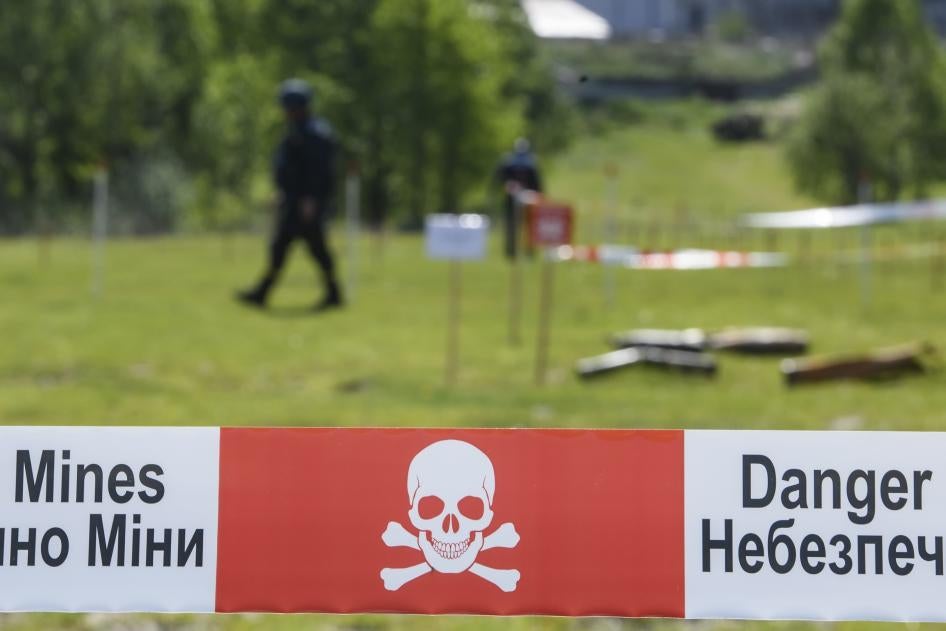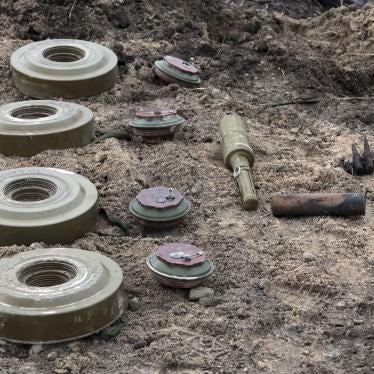(Geneva, November 17, 2022) – Governments should reiterate their support for the international treaty banning antipersonnel landmines, Human Rights Watch said today in releasing the annual Landmine Monitor report. Countries that have not ratified the 1997 treaty should promptly do so.
The 120-page Landmine Monitor 2022 report is the product of the International Campaign to Ban Landmines (ICBL), the global coalition of nongovernmental organizations chaired by Human Rights Watch that received the 1997 Nobel Peace Prize. Landmine Monitor 2022 will be presented at the Mine Ban Treaty’s annual meeting, held at the United Nations in Geneva from November 21 to 25, 2022.
“The Mine Ban Treaty has made a huge global impact over the past 25 years by stigmatizing antipersonnel mines and providing a framework for their eradication,” said Mary Wareham, arms advocacy director at Human Rights Watch and an editor of Landmine Monitor 2022. “Greater effort is needed to ensure the Mine Ban Treaty succeeds in achieving the goal of a world without antipersonnel mines, but that’s still far away.”
Antipersonnel mines are explosive devices that kill and maim people long after conflicts end. They are placed above, under, or on the ground and explode from a person’s presence, proximity or contact. They cannot distinguish between a soldier and civilian. Antipersonnel mines are typically placed by hand, but they can also be scattered by aircraft, rockets, and artillery, or dispersed from specialized vehicles. Uncleared landmines drive displacement, hinder the delivery of humanitarian aid, and prevent agricultural activities.
The Mine Ban Treaty, adopted in September 1997, comprehensively prohibits antipersonnel mines and requires countries to destroy stockpiles, clear mine-affected areas, and assist victims. A total of 164 countries are party to the treaty including all NATO members except the United States. In June, President Joe Biden set the US goal of ultimately joining the Mine Ban Treaty and realigned US policy with most of the treaty’s core prohibitions.
“Antipersonnel mines are unacceptable weapons that should never be used under any circumstances as they cause both immediate and long-term human suffering,” Wareham said. “Any military gains from using antipersonnel mines are far outweighed by the lasting humanitarian harm.”
Two countries have used antipersonnel mines in 2022. Myanmar’s armed forces have used antipersonnel landmines continuously since 1999. In the past year they have significantly increased new use around infrastructure such as mobile phone towers. Russia has used antipersonnel landmines repeatedly in Ukraine since its full-scale invasion of the country on February 24, creating an unprecedented situation in which a country that is not party to the Mine Ban Treaty is using the weapon on the territory of a treaty party.
Non-state armed groups have recently used antipersonnel mines in Central African Republic, Colombia, Democratic Republic of Congo, India, and Myanmar. This new use by armed groups mostly involved victim-activated explosive devices of an improvised nature made from locally available materials. The Mine Ban Treaty prohibits all victim-activated explosive devices regardless of whether they were improvised from local materials or produced in a factory.
Other major findings from Landmine Monitor 2022 include:
- At least 117,350 antipersonnel mines were cleared and destroyed worldwide in 2021;
- There were at least 5,544 new casualties from landmines and explosive remnants of war in 47 countries during 2021, including 2,182 deaths.
- Syria had 1,227 new landmine casualties in 2021, the highest number recorded in any country, followed by Afghanistan, with 1,074 new mine victims; and
- Where the age of victims was recorded, half of those killed or maimed in 2021 were children.
At least US$12.7 billion has been spent to support mine clearance and other mine action activities since the Mine Ban Treaty was adopted. In 2021, 32 donor countries provided a total of $543.5 million to mine action activities in 42 mine-affected countries. But 2021 was the fourth consecutive year in which international mine action support decreased.
Since the Mine Ban Treaty came into force on March 1, 1999, 30 states parties have completed the clearance of all antipersonnel mines from their territory. At least 60 countries and other areas are still contaminated by antipersonnel mines. At the Mine Ban Treaty’s Third Review Conference in 2014, a meeting held every five years, member states committed “to clear all mined areas as soon as possible, to the fullest extent by 2025.” Most of these mine-affected countries have deadlines obligating them to complete clearance in 2025 or sooner, yet few appear to be on track to do so.
Under the Mine Ban Treaty, 94 states parties have destroyed a total of more than 55 million landmines from their stockpiles. Sri Lanka completed the destruction of its landmine stocks in 2021. Greece and Ukraine both remain in violation of the treaty after repeatedly missing their stockpile destruction deadlines.
“Much more should be done to ensure that the needs of mine victims and mine-affected communities are met,” Wareham said. “With adequate resources and political will the Mine Ban Treaty can reach its goal of putting an end to the human suffering and casualties caused by antipersonnel mines.”









